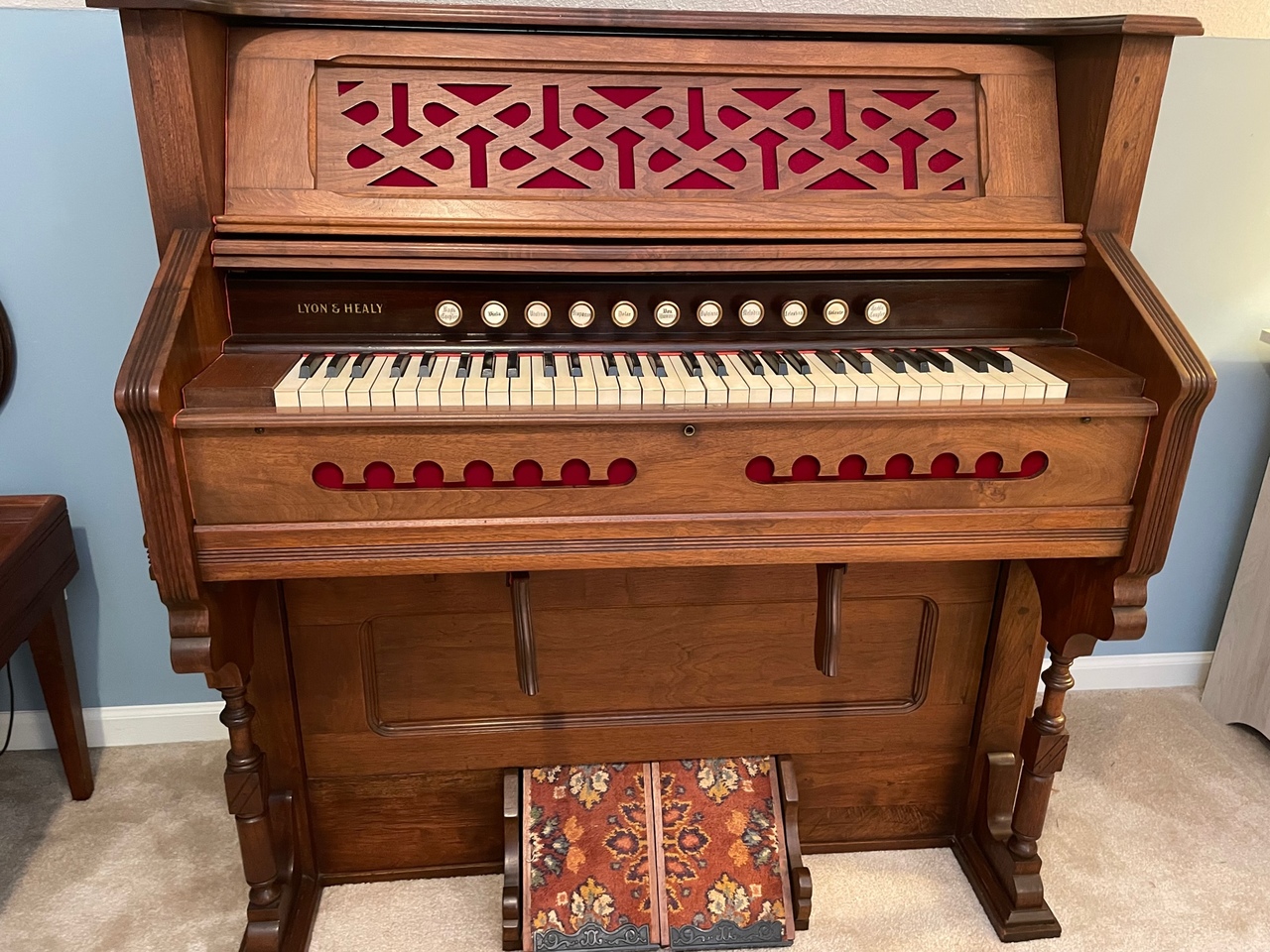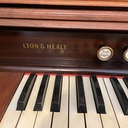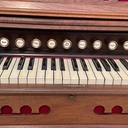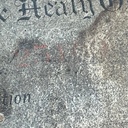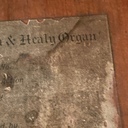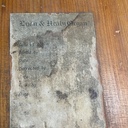Back to list view
I first retrieved this organ after getting permission from the then-living church trustees in the fall of 1969. When my uncle Freddie and a friend Gene went to the church on a misty fall day, we could not get up the road to the church because it had washed and rutted so badly. We literally had to maneuver our way through the brush and brambles to reach the building. The outside corner of the belfry had split wide open about 10-15 inches from the belfry to the foundation. We were risking our lives to enter the church and carry out the organ. I had just started my first year of teaching in the Kansas City area. My parents and Grandparents lived about three hours away in Gasconade County, MO. I was not yet married at that time, so I went home for Christmas break. I kept a record of my time: 100 hours to restore and rebuild the organ. Being only 22 at the time, I had never attempted anything like this and had no idea what I was getting into.
The organ was in such bad shape that I could not even tell of what wood the case was made. The back of the organ was made of interlocking panels. The rains had dissolved the glue and the pieces were scattered all over the floor of the church. We carried out parts and pieces in several stacks to the truck. All other church furniture had been carried away by this time, except the poor old, abandoned organ sitting in the corner, pedal straps broken, covered with layers of dust and grime, and even vandalized: someone apparently shot into the base with a .22 caliber shotgun!! What amazed me was that they did not take target practice on the faces of the stops. On this particular organ, the ivorine faces were held in place by copper rings which were “crimped” to conform to the circular rim of the stop pull itself. Of course, this copper seal was not revealed until the cleaning process was well under way.
Someone in my area knew of a “varnish stripper compound recipe.” I do not recall but I believe that it included sal soda. My Grandparents gave me permission to use one of their unused back rooms in their farmhouse for my workshop. I dismantled the organ, carefully placing each screw in a piece of cardboard, so I knew where to replace them. When I finally got down to the empty case, we carried it outside to the cistern pump where I mixed up the stripper recipe and painted it onto the wood. I actually sprayed the entire case down with a garden hose to wash away the remover. After a total of 3-4 applications, I finally had “clean” wood. My Dad, who worked with many types of wood, identified the organ as black walnut. I’m guessing that the word was unharmed by the water because of the extremely close grain. Believe it or not, none of the glue joints for the entire case were even weakened. However, all the loose pieces for the back, which we carried out in several stacks, had to be reglued. Would you believe that every single piece for the back was still there?!!
Because my background was science, I found it fascinating to “take apart a clock (organ) to see how it worked!!” There was a man in our small town who rebuilt player pianos. When I told him about my project, he gave me catalog information for purchasing bellows cloth, the horsehide glue crystals, new chamois valves, pedal hinges, etc. He gave me one ivorine key cover piece to replace part of the bass F. It was the only missing ivorine!! Because that note has a seam, at first glance one might think real ivory! Several of the black keys were slightly gnawed by mice. I simply cleaned, sanded a little, and returned the keys to the keyboard – the few gnawed keys added “character.”
My grandmother worked with me to glue the new bellows cloth into place. We kept a double boiler going on her gas stove in the kitchen to keep the glue hot enough. With 4 hands and 10 fingers we got all the bellows cloth into place and tacked the tack strips all around each of the two moving bellows. Once I reinstalled the bellows into the case, I decided to place empty plastic bread wrappers over the slits at the back “to see if my glue seals were leaking, or not.” And, to see if I had enough PRESSURE!! Imagine my great shock and surprise when I began to pump to see the plastic bread wrapper nearly SUCKED into the reservoir chamber!!
The organ was in such bad shape that I could not even tell of what wood the case was made. The back of the organ was made of interlocking panels. The rains had dissolved the glue and the pieces were scattered all over the floor of the church. We carried out parts and pieces in several stacks to the truck. All other church furniture had been carried away by this time, except the poor old, abandoned organ sitting in the corner, pedal straps broken, covered with layers of dust and grime, and even vandalized: someone apparently shot into the base with a .22 caliber shotgun!! What amazed me was that they did not take target practice on the faces of the stops. On this particular organ, the ivorine faces were held in place by copper rings which were “crimped” to conform to the circular rim of the stop pull itself. Of course, this copper seal was not revealed until the cleaning process was well under way.
Someone in my area knew of a “varnish stripper compound recipe.” I do not recall but I believe that it included sal soda. My Grandparents gave me permission to use one of their unused back rooms in their farmhouse for my workshop. I dismantled the organ, carefully placing each screw in a piece of cardboard, so I knew where to replace them. When I finally got down to the empty case, we carried it outside to the cistern pump where I mixed up the stripper recipe and painted it onto the wood. I actually sprayed the entire case down with a garden hose to wash away the remover. After a total of 3-4 applications, I finally had “clean” wood. My Dad, who worked with many types of wood, identified the organ as black walnut. I’m guessing that the word was unharmed by the water because of the extremely close grain. Believe it or not, none of the glue joints for the entire case were even weakened. However, all the loose pieces for the back, which we carried out in several stacks, had to be reglued. Would you believe that every single piece for the back was still there?!!
Because my background was science, I found it fascinating to “take apart a clock (organ) to see how it worked!!” There was a man in our small town who rebuilt player pianos. When I told him about my project, he gave me catalog information for purchasing bellows cloth, the horsehide glue crystals, new chamois valves, pedal hinges, etc. He gave me one ivorine key cover piece to replace part of the bass F. It was the only missing ivorine!! Because that note has a seam, at first glance one might think real ivory! Several of the black keys were slightly gnawed by mice. I simply cleaned, sanded a little, and returned the keys to the keyboard – the few gnawed keys added “character.”
My grandmother worked with me to glue the new bellows cloth into place. We kept a double boiler going on her gas stove in the kitchen to keep the glue hot enough. With 4 hands and 10 fingers we got all the bellows cloth into place and tacked the tack strips all around each of the two moving bellows. Once I reinstalled the bellows into the case, I decided to place empty plastic bread wrappers over the slits at the back “to see if my glue seals were leaking, or not.” And, to see if I had enough PRESSURE!! Imagine my great shock and surprise when I began to pump to see the plastic bread wrapper nearly SUCKED into the reservoir chamber!!
| Information | |
|---|---|
| ROS Reg No. | 6986 |
| Date Registered | 3/31/2023 |
| Views | 107271 |
| - | |
| Serial | 25100? |
| Manufactured Date | |
| Case Style | Parlor (with or without top) |
| Maker Location | |
| Model | |
| Knee swells | |
| Wood | Black Walnut |
| Keys | 61 |
| Manual(s) | 1 |
| Range | F-F |
| Stops | 11 |
| Pump method | Pumped by Foot |
| Stops |
|---|
| Bass Coupler |
| Viola |
| Violina |
| Diapason |
| Dulce |
| Vox Humana |
| Dulciana |
| Melodia |
| Celestina |
| Celeste |
| Treble Coupler |
